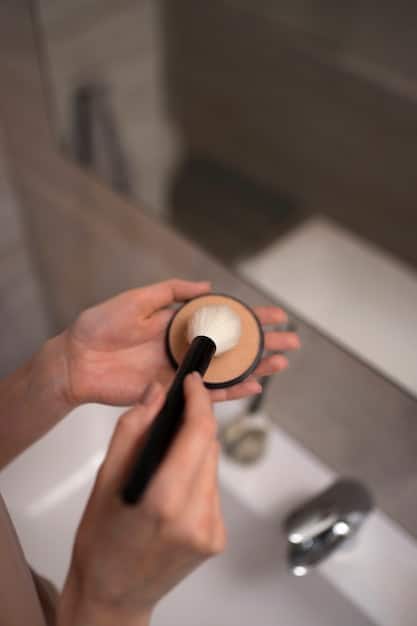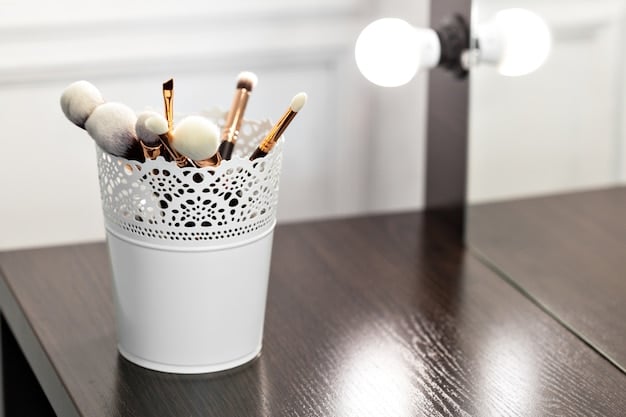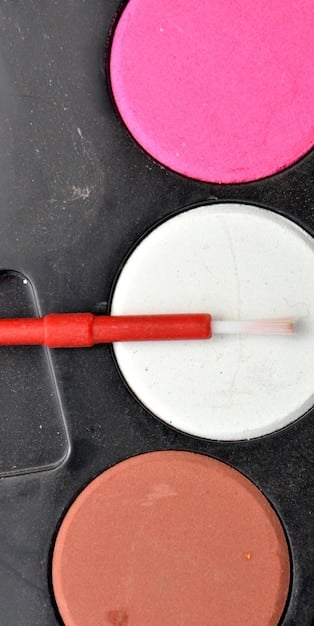How to Clean Makeup Brushes: Step-by-Step Guide (2025)

Advertisements
Cleaning your makeup brushes regularly is essential for maintaining healthy skin and ensuring flawless makeup application; this step-by-step guide provides you with the best practices for 2025.
Maintaining your makeup brushes is essential, and this how to clean your makeup brushes: a step-by-step guide for 2025 will help you keep them in top condition for flawless application and healthy skin.
Advertisements
Why Cleaning Your Makeup Brushes Matters
Regularly cleaning your makeup brushes extends their lifespan and safeguards your complexion. Dirty brushes harbor bacteria, oils, and accumulated makeup, leading to potential skin irritation, breakouts, and even infections. By adopting a consistent cleaning routine, you’re not only ensuring a smoother makeup application but also promoting healthier skin.
Think of your makeup brushes as an extension of your skincare routine. Just as you cleanse your face daily, your brushes require similar attention to prevent the transfer of impurities. Let’s delve into the essential aspects of why cleaning your brushes is a non-negotiable step in your beauty regimen.
Advertisements
Preventing Bacterial Buildup
Makeup brushes, especially those used with cream or liquid products, are breeding grounds for bacteria. The warm, moist environment within the bristles fosters microbial growth, which can then be transferred to your skin, causing acne and other skin problems.
Improving Makeup Application
Clean brushes ensure a smoother and more precise makeup application. Dirty brushes can become stiff and clogged with product, leading to streaks and uneven coverage. Regularly cleaning your brushes keeps them soft and pliable, resulting in a more professional finish.

- Reduces Skin Irritation: Dirty brushes can cause redness, itching, and inflammation.
- Enhances Product Performance: Clean brushes apply makeup more effectively and evenly.
- Extends Brush Lifespan: Regular cleaning prevents bristles from breaking down prematurely.
In conclusion, cleaning your makeup brushes is not just about hygiene; it’s about optimizing your beauty routine for the best possible results. It’s a small investment of time that yields significant benefits for your skin and your makeup.
Essential Supplies for Brush Cleaning in 2025
To effectively clean your makeup brushes in 2025, you’ll need a few essential supplies. These include a gentle cleanser, a cleaning mat or glove, and a clean towel for drying. The right tools and products will make the process easier and more efficient, ensuring your brushes are thoroughly cleaned and well-maintained.
Having the right supplies on hand makes the brush cleaning process less of a chore and more of a seamless part of your beauty routine. Let’s explore the must-have items for keeping your brushes in pristine condition.
Gentle Cleanser
A gentle cleanser is crucial for removing makeup residue without damaging the delicate bristles. Look for a soap or shampoo specifically designed for makeup brushes, or opt for a mild, fragrance-free baby shampoo. Harsh soaps can dry out the bristles and shorten the lifespan of your brushes.
Cleaning Mat or Glove
A textured cleaning mat or glove aids in the deep cleaning process by providing a surface to agitate the bristles and dislodge stubborn makeup. These tools usually feature different textures and patterns to effectively clean various brush types and sizes.

- Clean Towel: Use a clean towel to gently remove excess water from the brushes after washing.
- Brush Drying Rack: A drying rack allows brushes to air dry upside down, preventing water from seeping into the ferrule and weakening the glue.
- Isopropyl Alcohol: For quick sanitizing, isopropyl alcohol can be used to disinfect brushes between deep cleans.
In summary, gathering the right supplies ensures you have everything you need to effectively clean and maintain your makeup brushes. These tools not only simplify the cleaning process but also protect your brushes, extending their lifespan and performance.
Step-by-Step Guide to Cleaning Your Brushes
Cleaning your makeup brushes might seem daunting, but with a step-by-step guide, it becomes a manageable and essential part of your beauty routine. By following these instructions, you can ensure your brushes are clean, hygienic, and ready for flawless makeup application.
This step-by-step guide breaks down the brush cleaning process into easy-to-follow instructions, making it simple to maintain your brushes and promote healthier skin. Let’s get started.
Step 1: Wet the Bristles
Start by wetting the bristles of your makeup brush with lukewarm water. Make sure to hold the brush with the bristles pointing downward to prevent water from getting into the ferrule (the metal part that connects the bristles to the handle), as this can loosen the glue over time.
Step 2: Apply Cleanser
Dispense a small amount of your chosen cleanser onto the bristles or a cleaning mat. Gently swirl the brush in the palm of your hand or on the textured surface of the cleaning mat to create a lather.
- Step 3: Rinse Thoroughly: Rinse the bristles under lukewarm water until all traces of soap and makeup are gone.
- Step 4: Gently Squeeze Out Excess Water: Use your fingers to gently squeeze out excess water from the bristles.
- Step 5: Reshape the Bristles: Reshape the bristles to their original form to maintain the brush’s shape and performance.
In conclusion, by following these steps diligently, you can effectively clean your makeup brushes and keep them in top condition. This routine not only improves your makeup application but also promotes healthier skin by eliminating bacteria and impurities.
Best Practices for Drying Your Makeup Brushes
Proper drying is as crucial as the cleaning process itself. Improper drying can lead to mildew and bacteria growth, defeating the purpose of cleaning. By following these best practices, you can ensure your brushes dry thoroughly and remain in excellent condition.
Optimal drying techniques extend the life of your brushes and maintain their hygiene, ensuring they’re always ready for use. Let’s explore the best ways to dry your makeup brushes effectively.
Air Drying Upside Down
Air drying your brushes upside down is the best method to prevent water from seeping into the ferrule, which can loosen the glue and damage the brush. You can use a brush drying rack or simply clip the brushes to a hanger with the bristles pointing downward.
Using a Clean Towel
After washing, gently blot the bristles with a clean towel to remove excess water. Avoid rubbing the bristles vigorously, as this can cause them to fray or break. A soft touch ensures the bristles remain intact and maintain their shape.
- Avoid Direct Sunlight: Do not dry your brushes in direct sunlight, as this can damage the bristles and cause them to fade.
- Ensure Proper Ventilation: Dry your brushes in a well-ventilated area to facilitate quicker and more thorough drying.
- Check for Complete Dryness: Before storing your brushes, ensure they are completely dry to prevent mold and bacteria growth.
In summary, adhering to these drying best practices is essential for maintaining the integrity and hygiene of your makeup brushes. Proper drying prevents damage, extends their lifespan, and ensures they remain a valuable part of your beauty toolkit.
How Often Should You Clean Your Brushes?
Determining the frequency of brush cleaning depends on usage and the types of products used. Regular cleaning is paramount to prevent the buildup of bacteria and maintain optimal performance. By establishing a consistent cleaning schedule, you can ensure your brushes remain hygienic and effective.
The frequency of cleaning can vary, but adopting a routine that aligns with your makeup habits ensures your brushes stay in top condition. Let’s delve into the ideal cleaning frequency for different brush types.
Daily Cleaning for Foundation and Concealer Brushes
Brushes used for applying foundation and concealer should be cleaned daily or after each use. These products are often thick and can trap bacteria more easily. Daily cleaning prevents buildup and ensures a smoother, more hygienic application.
Weekly Cleaning for Powder Brushes
Brushes used for applying powder products, such as blush, bronzer, and eyeshadow, should be cleaned at least once a week. Powder products tend to accumulate more slowly, but weekly cleaning still prevents bacterial growth and maintains brush quality.
- Spot Cleaning: Use a brush cleaner spray for quick spot cleaning between deep cleans.
- Monitor Brush Condition: Pay attention to the condition of your brushes. If they appear dirty or feel stiff, it’s time for a cleaning.
- Adjust Based on Skin Type: If you have sensitive or acne-prone skin, consider cleaning your brushes more frequently to minimize the risk of irritation.
In conclusion, establishing a regular cleaning schedule is crucial for maintaining the hygiene and performance of your makeup brushes. Adjust the frequency based on your usage and skin type to achieve the best results.
Advanced Tips for Maintaining Brush Quality in 2025
Beyond regular cleaning, there are advanced maintenance tips that can extend the lifespan and performance of your makeup brushes. These tips involve proper storage, handling, and occasional deep cleaning to ensure your brushes remain in optimal condition.
These advanced tips ensure that your brushes not only stay clean but also maintain their original quality and shape. Let’s explore these essential maintenance practices for 2025.
Proper Storage Techniques
Storing your brushes correctly can prevent damage and maintain their shape. Use a brush holder or organizer to keep them upright and separated, preventing the bristles from bending or fraying. Avoid storing brushes in a cluttered drawer where they can be crushed or damaged.
Deep Cleaning Methods
In addition to regular cleaning, perform a deep clean every few months to remove stubborn residue and buildup. Soak the brushes in a mixture of water and vinegar for a few minutes, then rinse thoroughly and allow them to dry. This method helps to sanitize and refresh the bristles.
- Avoid Harsh Chemicals: Do not use harsh chemicals or solvents to clean your brushes, as these can damage the bristles and shorten their lifespan.
- Handle with Care: Avoid pulling or tugging on the bristles when cleaning or drying, as this can cause them to break or fall out.
- Inspect Regularly: Regularly inspect your brushes for signs of wear and tear, such as frayed bristles or loose ferrules. Replace brushes as needed to maintain optimal performance.
In summary, by implementing these advanced maintenance tips, you can extend the lifespan and improve the performance of your makeup brushes. Proper storage, deep cleaning, and careful handling ensure your brushes remain a valuable asset in your beauty routine.
| Key Point | Brief Description |
|---|---|
| 🧼 Regular Cleaning | Prevents bacteria buildup, improves application. |
| 🧽 Essential Supplies | Gentle cleanser, cleaning mat, clean towel. |
| 💨 Proper Drying | Air dry upside down, avoid direct sunlight. |
| 📅 Cleaning Frequency | Daily for foundation, weekly for powder brushes. |
FAQ: Cleaning Makeup Brushes like a Pro
▼
Use a gentle cleanser specifically designed for makeup brushes, or a mild, fragrance-free baby shampoo. Avoid harsh soaps that can damage the bristles.
▼
Gently squeeze out excess water, reshape the bristles, and air dry upside down. Using a brush drying rack can also speed up the process.
▼
Yes, isopropyl alcohol can be used for quick sanitizing between deep cleans. However, avoid frequent use as it can dry out the bristles.
▼
Natural bristles require extra care. Use a gentle cleanser and avoid soaking the ferrule to prevent the glue from loosening.
▼
Store your brushes upright in a brush holder or organizer to prevent the bristles from bending or fraying. Keep them away from direct sunlight and humidity.
Conclusion
Mastering the art of cleaning your makeup brushes is a pivotal step in maintaining both your beauty tools and your skin’s health. By following this comprehensive guide for 2025, you can ensure your brushes remain hygienic, effective, and ready to deliver flawless makeup applications for years to come.